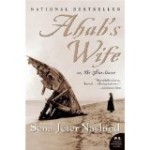Sailor, Sinner, Stargazer

It took me 16 years to get around to this book and another 16+ hours to read it, but discovering a remarkable female heroine was the priceless reward. Like Sarah Grimké in The Invention of Wings, Una is a Southerner who goes North in the first half of the 19th century, discovers her true self, and embraces feminists and abolitionists. My son-in-law, Sean, surprised that I had never read Moby Dick, gave me a copy soon after we first met twelve years ago. Now I have a companion for that classic novel. Sena Jeter Naslund is a supremely gifted writer who imagines whaling from a woman’s point of view. It’s not an easy read, but very rewarding. The musical equivalent for Ahab’s Wife would be a modern woman composer, say Amy Scurria (Rice ’95), presenting her own version of Beethoven’s Eroica symphony. Amy has already written an opera, Pearl, inspired by Hawthorne’s The Scarlet Letter, so she is familiar with strong women in New England.
Cutting off her curly hair and dressing as a cabin boy, 16-year old Una Spenser talks her way on to a whaling ship and up to the top of the mast. From that vantage, we see and hear what such a ship was like:
The possibility of sighting whales began to excite the atmosphere on board, and the sound of hasps honing the steel of lances and harpoons filled our ears throughout the day. Many a sailor sat on the deck…his whetstone moving back and forth against the edge of his harpoon, or lance, or cutting spade. These edges were stroked to the point of flashing silver, and all over the deck when I was above, I could see the short reflective dashline of a sharpened steel edge. High above the din, the sound put me in mind of a pack of demons patiently filing their teeth. Another lookout saw a whale, a right whale, and we gave chase, though the sperm whale was preferred. The beast escaped us. Nonetheless, the sighting sharpened the edge of excitement the way the whetstones sharpened the killing tools.
What an image to recall when Steve sharpens his carving knife for the Thanksgiving turkey! But back in the 1830s, Una’s ship meets disaster; she is one of only three to survive. This is when she becomes a Sinner with a capital S. Stargazing, later in life, is part of her expiation. Una’s journey is complex, as one might expect from the very first sentence: “Captain Ahab was neither my first husband nor my last.” It’s as if Naslund is challenging Melville’s memorable “Call me Ishmael.”
One of the independent women Una encounters in Nantucket is Maria Mitchell, the first professional woman astronomer in the United States. Mitchell discovered a new comet in 1847. Una observes, “Maria seemed content merely to focus on what she herself wanted to do. Perhaps that was as good an answer as any to the question of the status of women.” Another fierce woman is Una’s cousin Frannie, who becomes an ardent advocate for freeing slaves and welcoming them into mainstream society.
The Atlantic Ocean is a vivid character in this book. Descriptions like the following show the value of investing time with Ahab’s Wife:
I SEE IT NOW: the first morning on the beach at ‘Sconset, the waves roll in on long diagonals. The water builds and builds to a steep, high crest and then folds in the middle into a high line of foam which quickly dips in front and spreads on each side in a widening scallop. Rolling in, the wave scampers itself into a flowing, milky apron of white. How densely white this froth, more cream than milk! And behind this turbulent flounce of white, from the backside of the translucent crest, floats a broken net of think foam, patterned like a mosaic.
Leave a Reply